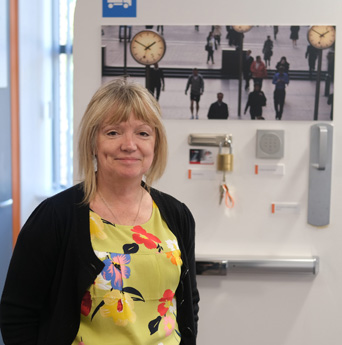Safety of residents and staff in specialised housing environments has always been a priority for those in the sector. Karen Trigg of physical security product manufacturer Allegion UK, pictured, highlights the steps decision makers must make to keep occupants in sheltered, extra care or supported housing safe and secure.
Whether it’s adhering to fire safety or infection control guidelines – a topic that is never far from our thoughts at the moment – there are many options that decision makers can take to ensure maximum safety and compliance in specialised housing settings.
Only recently, the pandemic has left facilities such as care homes and their staff under scrutiny over their infection control methods. And now, with the winter period playing a role in the spread of common colds and such, infection control, along with the safety of occupants, is rife in the news. So with that in mind, what are the steps that must be taken to ensure occupants in supported housing stay safe and secure?
Providing a safe environment for all doesn’t have to be a complex process, although it is important that the process is thorough, with occupants in these settings potentially far more vulnerable to injury or worse in the event of a fire. The same is true for infection control, where robust policies and protocols should be in place to protect those living in supported housing, as well the staff looking after them.
The National Fire Chiefs Council’s (NFCC) comprehensive guide for specialised homes, published in 2017, includes many proposals, all designed to protect the estimated three quarters of a million residents situated in specialised housing in the UK.
Further to this, in January 2020, the Scottish Government strengthened its response to fire safety – the Practical fire safety for existing specialised housing and similar premises: guidance – which is aimed at housing and care providers, as well as care regulators and care service commissioners.
Both reports detail ways in which specialised homes should work to minimise fire risk to protect both the people living, working and visiting there, and the building itself.
Examining the statistics surrounding fire safety in these environments, it’s unsurprising that it remains a priority. According to the NFCC report, sheltered and extra care housing accounts for about 2pc of housing stock, but between 2010 and 2016, they accounted for about 7pc of fires – a critical finding.
From this, London Fire Brigade’s eight-page document distilled the main information and includes a person-centred fire risk assessment checklist and a list of the main fire safety management procedures, such as testing fire doors and fire alarms, record-keeping and essential maintenance. Crucially, fire doors and their appropriate door hardware, such as mechanical and electromagnetic closers and panic emergency exit hardware, must be fitted correctly and regularly checked to ensure these heavily used products are fit for purpose.
However, key for specialised housing, it’s important to remember that there is no one-size-fits-all solution to fire safety products. Residents for example, must be comfortable using fire doors and their hardware, thus removing the risks associated with heavy or non-functional doors that residents in these settings may have additional problems operating. Decision makers are advised to consult a door hardware expert, who will provide further guidance as to the products that will best meet the needs of a specific facility. These experts consider such issues as assessing the emergency access and egress systems, as well as establishing how best to accommodate the needs of all occupiers and staff.
Infection control has long been front and centre of people’s minds – and never more so since the covid-19 pandemic, which highlighted the endemic risks in all commercial, healthcare, domestic and care home settings.
In 2018, a report conducted by Allegion UK revealed that while 80pc of infections are transmitted through the enivornment, only 71pc of healthcare facilites used environmental cleaning to prevent the spread of infection. Furthermore, just 52pc of healthcare respondents said they were satisfied that their existing infection control measures were robust and effective.
The potential for exposure to pathogens is significant within specialised home settings. While hand washing and disinfection protocols, as well as ventilation procedures, all form an important part of infection control, there are additional measures that can be taken, such as installing antibacterial door hardware, handles and levers in high-traffic areas.
These solutions contain added antibacterial protection to help eliminate potentially harmful bacteria and defend against the spread of microorganisms. Where health risks are more probable, this provides extra peace of mind when it comes to maintaining the highest levels of hygiene and minimising the risk of contamination.
It’s also key to observe the building’s emergency exits. Emergency exit devices can also be coated with antibacterial properties, contributing to both fire safety standards and now infection control, by reducing the risk of cross-contamination, providing long-lasting protection and enabling people to escape a building quickly. Furthermore, touchless electromagnetic door controls can assist with ease of movement, fire safety and infection control by being linked to the building’s alarm system, closing shut in the event of a fire and eliminating the need for people to wedge the doors open.
In what is now a critical time for many specialised housing facilities, decision makers must take responsibility in their choices to help meet both the fire safety and infection control requirements that have been set.
While it’s true that the varied nature of running sheltered, extra care and supported housing facilities can make decisions feel like complex challenges, today’s hardware solutions provide one helpful and easy solution, enabling higher levels of building safety and security – and that is more important than ever.









